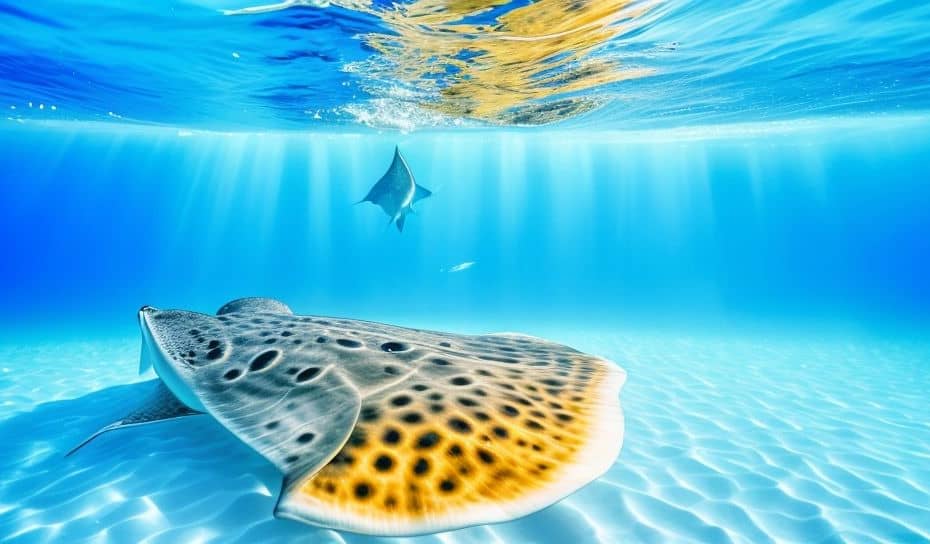Are you thinking of getting a freshwater stingray for your aquarium? If so, it’s important to understand how to properly care for these unique and interesting creatures. In this guide, we’ll show you all you need to know about creating the right environment, feeding, and looking after your freshwater stingray.
Let’s discuss the basics of caring for a freshwater stingray. They require a large tank with plenty of space to swim in, as they have a large wingspan and love to move gracefully through the water. It’s essential to provide them with a sandy substrate, as their underside is delicate and can get hurt on harsh surfaces.
Regarding feeding your freshwater stingray, make sure you offer them a variety of foods. They are carnivorous and benefit from a diet of shrimp, fish, and other small aquatic animals. Offer them live or frozen food to excite their natural hunting instincts. Don’t overfeed them to prevent overfeeding and water pollution.
Another cool thing about freshwater stingrays is that they can hide in their environment. They have special cells that allow them to change colors and patterns on their skin. This helps them avoid predators and adds a beautiful touch to any aquarium.
Understanding Freshwater Stingrays
To better understand freshwater stingrays, delve into their characteristics, natural habitat, and behavior. Learn about the unique features and traits that make freshwater stingrays fascinating, as well as their preferred environment and the way they naturally behave.
Characteristics of Freshwater Stingrays
Freshwater stingrays are awe-inspiring! They have distinct flat bodies, like light-colored pancakes, with long tails and venomous spines. Mostly living in sandy or muddy riverbeds, they can use their specialized organs, called ampullae of Lorenzini, to detect electrical fields. This sixth sense helps them find food and avoid threats.
Their pectoral fins help them swim effortlessly, even though they may look clumsy. These creatures can grow up to several feet in diameter – quite an impressive sight!
Did you know that some species of freshwater stingrays give birth instead of laying eggs? This provides immediate protection for their young and increases their chance of survival.
An interesting historical anecdote about freshwater stingrays comes from the Amazon rainforest. Fishermen found a venomous creature hidden in the beauty of a graceful animal. This discovery created curiosity among scientists and allowed us to explore and understand more about these amazing creatures.
With such unique characteristics, freshwater stingrays continue to captivate researchers and fans. By studying them, we gain a greater appreciation for these magnificent animals that live in rivers and waterways.
Natural Habitat and Behavior
Discover the captivating world of freshwater stingrays. They possess a venomous spine near their tail for self-defense. And they produce electrical discharges to help them with navigation and hunting.
Where do they live?
- Rivers – they prefer slow-moving rivers with sandy or muddy bottoms.
- Lakes – they can be found in lakes and reservoirs if conditions are suitable.
- Swamps – occasionally they venture into swamps and marshes.
Their Diet:
These creatures mainly feed on small crustaceans, fish, and mollusks.
Behavior:
- Docile – hides during the day, foraging for food at night.
- Camouflage – blends in with surroundings, hard to spot.
- Solitary – rarely seen in groups, prefers to spend time alone.
Mating Rituals:
Freshwater stingrays have fascinating mating rituals with elegant courtship dances.
Research:
Explorers and scientists have studied these unique creatures for many years, and our understanding of them continues to grow. To learn more secrets about what they call home, dive deeper into the world of freshwater stingrays.
Setting Up the Freshwater Stingray Tank
To ensure a successful freshwater stingray tank setup, focus on tank size, water conditions, filtration, and suitable tankmates. These sub-sections provide the solution you need. Determine the ideal tank size and setup, maintain optimal water conditions and filtration, and carefully select compatible tankmates for a harmonious and thriving freshwater stingray environment.
Tank Size and Setup
Establishing a successful freshwater stingray tank requires careful planning. Here are five points to keep in mind:
- A tank size of at least 200 gallons will provide plenty of room for the stingrays to swim.
- Use fine sand or gravel for the substrate. This will allow the stingrays to search for food.
- Install a powerful filtration system to maintain water quality. They are sensitive to ammonia and nitrate levels.
- Provide hiding spots with rocks, driftwood, or PVC pipes. Stingrays need secluded areas.
- Keep the temperature between 75-80°F. This replicates their natural habitat.
Also, be aware that freshwater stingrays should not be housed with aggressive or territorial fish species. Conflict and stress can arise if this precaution is not taken.
Dr. William Gery uncovered the first freshwater stingray species in the Amazon River in 1969. His research uncovered these mysterious creatures and inspired further exploration into studying and caring for them in captivity. This groundbreaking moment empowered enthusiasts to set up successful freshwater stingray tanks, similar to their natural habitat.
Water Conditions and Filtration
The well-being of these unique freshwater stingrays depends on the right water conditions and filtration in their tank. Let’s take a look at the key aspects related to their habitat.
Water Conditions:
Maintaining the best environment for your stingrays requires monitoring and adjusting their temperature, pH levels, hardness, and ammonia levels. Here’s a table of the recommended ranges for each parameter:
| Parameter | Recommended Range |
|---|---|
| Temperature | 78-82°F (25-28°C) |
| pH Level | 6.8-7.5 |
| Water Hardness | 2-15 dGH |
| Ammonia Levels | 0 ppm |
By keeping these conditions within the ideal ranges, you’ll be creating a healthy home for your stingrays.
Filtration:
Don’t forget to invest in a high-quality filtration system. This is essential for removing waste particles, excess nutrients, and harmful substances from the water.
Fun Fact: Did you know that some freshwater stingrays can grow up to lengths of over three feet (1 meter)? They sure are amazing creatures!
Suitable Tankmates
When choosing tankmates for a freshwater stingray, there are certain things to keep in mind. Go for fish of similar size, peace-loving species like tetras, gouramis, and catfish. Also, bottom-dwellers like loaches or cories. But beware of aggressive or territorial fish, as they can cause stress and harm.
Remember, it is possible to keep multiple stingrays in one tank; however, you need a large aquarium. This ensures the fish have enough space and hiding spots. As stingrays are solitary creatures, they may show aggression toward each other if cramped.
Pro Tip: Think carefully when selecting tankmates for your freshwater stingray to create a balanced community tank.
Handling and Care
To ensure proper handling and care of freshwater stingrays, acquire a solid understanding of proper handling techniques and maintain the tank. Delve into the subtleties of each sub-section and discover the best practices to ensure the well-being of these mesmerizing aquatic creatures.
Tank Maintenance
- Regularly clean the tank and remove any debris or algae for a healthy environment for inhabitants.
- Test the water often for pH, ammonia, nitrite, and nitrate to suit your fish.
- Clean or replace filters to keep them efficient at removing impurities.
- Monitor the tank’s temperature and make sure it stays in the ideal range.
- Inspect equipment like heaters, air pumps, and lights to spot issues and replace faulty parts quickly.
- Every few weeks, replace around 20% of the water to reduce toxins and add minerals.
- Keep a routine for cleaning, testing, and changing filters.
- Purchase quality tools and test kits.
- Research new fish before introducing them.
- Consult professionals if needed.
Following these tips will give you and your underwater friends a thriving aquatic ecosystem.
Common Health Issues and Prevention
To ensure the well-being of your freshwater stingrays, equip yourself with the necessary knowledge on common health issues and prevention. Disease prevention, identifying common health problems, and treatment and care are the key sub-sections that will provide you with effective solutions to maintain the health of your beloved freshwater stingrays.
Conclusion
Let’s wrap up our beginner’s guide to freshwater stingray care! We’ve learned about setting up the right tank environment, providing the necessary diet and maintaining water conditions. Here’s a summary of successful stingray care:
- Creating the ideal habitat is important. Ensure a spacious tank with a smooth substrate and hiding spots. Clean water is a must – use filtration and conditioning.
- Nutrition is key – give them a varied diet of high-quality foods like fish, shrimp and ray pellets. Balance proteins, vitamins and minerals for health.
- Live plants or driftwood can make them feel comfortable. Monitor water parameters like temperature, pH levels and ammonia.
- Additional suggestions: inspect their bodies for any signs of injury or infection. Watch out for changes in behavior or appetite – these can indicate problems.
Each suggestion plays an important role in providing the best care. With diligent implementation, you can create an ideal environment for their well-being and longevity.
Frequently Asked Questions
Q: Can freshwater stingrays be kept in a regular fish tank?
A: No, freshwater stingrays require a larger tank with a minimum size of 200 gallons.
Q: What should I feed my freshwater stingray?
A: Freshwater stingrays have a diverse diet that includes live or frozen meaty foods such as shrimp, fish, and worms.
Q: Do freshwater stingrays require any special water conditions?
A: Yes, freshwater stingrays need soft and acidic water with a pH level between 6.0 and 7.0.
Q: How often should I clean the tank for freshwater stingrays?
A: It is recommended to perform partial water changes of about 25% every two weeks and thoroughly clean the tank at least once a month.
Q: Can freshwater stingrays live with other fish species?
A: Freshwater stingrays are generally not compatible with other fish, as they may try to eat smaller tankmates.
Q: Is it necessary to provide hiding spots in the tank for freshwater stingrays?
A: Yes, it is crucial to create hiding spots in the tank using rocks, driftwood, or PVC pipes to allow freshwater stingrays to feel secure.

